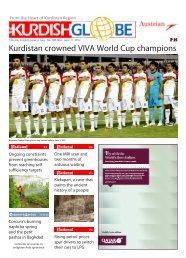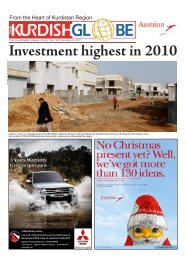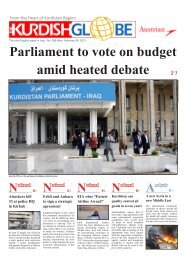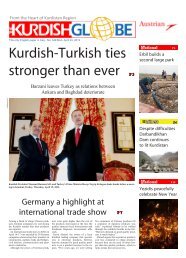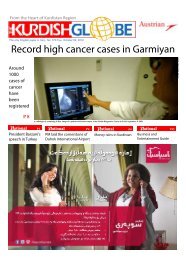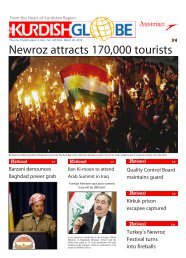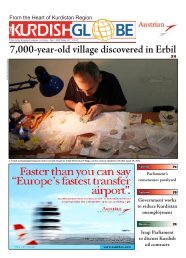The <strong>Kurdish</strong> <strong>Globe</strong> No. 314, Saturday, July 23, 2011 8Visit<strong>in</strong>g Salad<strong>in</strong>'shometownGLOBE PHOTO / Qassim KhidhirThe famed Arab leaderhad roots <strong>in</strong> KurdistanA view of Dw<strong>in</strong> castle ru<strong>in</strong>s near Erbil.The m<strong>in</strong>ute you leave thePirmam town <strong>in</strong> Erbilcity, the capital of IraqiKurdistan, on the leftside of the ma<strong>in</strong> street,there is a narrow sidestreet that goes throughArmawa <strong>and</strong> Zrgos villclages.Driv<strong>in</strong>g 10 m<strong>in</strong>utesfrom Zrgos, you will seecastle ru<strong>in</strong>s on a top of amounta<strong>in</strong> on the left sideof the street, <strong>and</strong> on theright side, an old graveycyard. The castle <strong>and</strong> thearea are called Dw<strong>in</strong>,the hometown of Saladcd<strong>in</strong> Ayoubi. Salad<strong>in</strong> wasa <strong>Kurdish</strong> Muslim, whobecame the first sultanof Egypt <strong>and</strong> Syria, <strong>and</strong>founded the Ayoubi Dyncnasty. He led Muslim<strong>and</strong> Arab opposition tothe Franks <strong>and</strong> other Eurcropean Crusaders <strong>in</strong> theLevant. At the height ofhis power, his sultanate<strong>in</strong>cluded Egypt, Syria,Mesopotamia, Hijaz <strong>and</strong>Yemen. Under his leadecership, his forces defeateced the Crusaders at theBattle of Hatt<strong>in</strong>, lead<strong>in</strong>gthe way to recaptur<strong>in</strong>gPalest<strong>in</strong>e, which the Cruscsaders had seized fromthe Fatimid Egyptians 88years earlier.Internationally, thereis not much <strong>in</strong>formationabout Dw<strong>in</strong> village orcity. The only mentionis that Salad<strong>in</strong>'s parentscame from Dw<strong>in</strong>. Locallcly, there are some booksabout Salad<strong>in</strong>'s family,how they lived <strong>and</strong> whatthey did <strong>and</strong> about Saladcd<strong>in</strong>'s tribe, the Zarzary.The most notable is abook written by <strong>Kurdish</strong>historian Abdul KhaleqSarsam, who died twoyears ago, which saysthe castle belonged toSalad<strong>in</strong>'s gr<strong>and</strong>father,Jalaladd<strong>in</strong>.The foundation of thecastle <strong>and</strong> some partsof the walls are clearlyvisible, <strong>and</strong> the castle'sguard posts are stillpartially st<strong>and</strong><strong>in</strong>g. Thecastle is built of mountcta<strong>in</strong> stone, one of thereasons it hasn't disappcpeared completely. Thecastle is on high ground<strong>and</strong> controlled the roadon both directions. ReneTurner — a heritage expcpert who works for Briticish Conservation <strong>and</strong>Development Company,a consultancy companythat wrote the renovationmaster plan for Erbil's7,000-years-old Citadel— believes the castle <strong>and</strong>its guard posts were builtto watch <strong>and</strong> protect thevillage, which is at thefoot of the mounta<strong>in</strong>, onthe river. You can stillsee remnants of the villclage that was once thehome of Salad<strong>in</strong>'s gr<strong>and</strong>fcfather. Out of personal<strong>in</strong>terest, Turner has visicited the site several times<strong>and</strong> believes it has potentctial as a tourist attraction,especially if a small arcchaeological team cleansthe site <strong>and</strong> uncoversthe ground floor of thecastle. But Turner doesnot recommend rebuildic<strong>in</strong>g the castle. "There isno <strong>in</strong>formation so far onwhat the castle lookedlike. A castle should notbe rebuilt there basedon imag<strong>in</strong>ation, becausethen it will become Disncney." He added, "Cleanic<strong>in</strong>g the site <strong>and</strong> add<strong>in</strong>gsome signs about its histctory <strong>and</strong> background ismore attractive for touricists than to rebuild thecastle based on imag<strong>in</strong>atction."A historical graveyardsits on the opposite sideof the road. Some of thegraves have <strong>in</strong>scriptions,while others are blank.Turner says the gravesdate back to differenteras. The graves at thebeg<strong>in</strong>n<strong>in</strong>g of the graveycyard are from the era ofthe Zoroastrian, a religion<strong>and</strong> philosophy from thesixth century. The graveshave suns, daggers <strong>and</strong>swords, three symbols ofthe Zoroastrian religion.The graves beside a rockwall date back to Saladcd<strong>in</strong>'s era. Accord<strong>in</strong>g tolocal legend, one of thegraves belongs to Saladcd<strong>in</strong>'s gr<strong>and</strong>father. A thirdgroup of graves is around200 years old, some withbeautiful <strong>in</strong>scriptions,most notably <strong>in</strong>scriptionsfor knights.Kurdistan was listedamong the top 20 touristdest<strong>in</strong>ations <strong>in</strong> 2010 byNational Geographic <strong>and</strong>The Wash<strong>in</strong>gton Post.Kurdistan has more than3,000 heritage sites <strong>and</strong>98 percent of them havenot yet been cleaned, rescstored or excavated.156,179 tourists visited Kurdistan <strong>in</strong> JuneDirector of Tourism Affcfairs of General Board ofTourism of the Kurdistctan Region Omed Kaifi,told the <strong>Globe</strong> 108,442tourists visited Erbil <strong>in</strong>June, while 22,313 touricists visited Duhok <strong>and</strong>25,964 visited Suleimcmaniya.The total was 156,179visitors <strong>in</strong> June, eventhough the Region'sschool exam<strong>in</strong>ation percriod had not ended.Accord<strong>in</strong>g to 2007 estctimates, 337,000 touricists visited KurdistanRegion. In 2010, visitorsto the Region numbered1,313,000. “So, thenumber of tourists hasdramatically <strong>in</strong>creased<strong>in</strong> 2010. This is a clearmessage that year afteryear, the numbers will<strong>in</strong>crease,” said Kaifi.Based on visitorsspend<strong>in</strong>g $100 each,for 2010 the contributction to the KurdistanRegion economy was$131,300,000.
The <strong>Kurdish</strong> <strong>Globe</strong> No. 314, Saturday, July 23, 2011 9Kurdistan Region prisonsneed urgent improvementHawj<strong>in</strong>Rashadadd<strong>in</strong>Erbilhawj<strong>in</strong>.kurdishglobe@gmail.comKurdistan Regionprisons have few suppplies<strong>and</strong>workshops whereprisoners can learnnew skills to helpthem when they'rereleased. Under thesecircumstances, somefear prisoners willlearn new ways tocommit crimes.The Directorate of ReformPrisons is the authority rescsponsible for help<strong>in</strong>g prisoconers return to society, butit seems to have few rescsources.A social researcher workic<strong>in</strong>g <strong>in</strong> the field of prisonreform <strong>and</strong> care, ShwanSabir, reported the Region'sprisons offer little <strong>in</strong> theway of reform.“The supervisors of theprisons say they have speccial workshops <strong>in</strong> theirprisons to tra<strong>in</strong> prisoners sothey can acquire skills. But,when we visit those prisons,we f<strong>in</strong>d out they don't havesupplies <strong>and</strong> the mach<strong>in</strong>erydoesn't work. If the prisonecers want to produce items,there's no market for them.So, if they learn blacksmithic<strong>in</strong>g, carpentry <strong>and</strong> tailor<strong>in</strong>g,they aren't able to sell theirproducts,” said Sabir whohas conducted research onprison conditions with IraqJustice Network.Although the governmentbuys the supplies at fullprice, there is no plan soworkshops <strong>in</strong> the prisonscan buy the items at lowerprices to make them moref<strong>in</strong>ancially viable.Economic experts <strong>in</strong> theThe Tasluja 51-megawattpower station <strong>in</strong> Suleimcmaniya should have beenf<strong>in</strong>ished at the beg<strong>in</strong>n<strong>in</strong>g of2008, but it is still not genecerat<strong>in</strong>g power.The project was run byKorean UI Energy Compancny which started the projecton April 29, 2007. It wasorig<strong>in</strong>ally planned as a 91-megawatt power station,but the government reducedit to 51 megawatts to speedcompletion. It was suppcPrisons may "teach" <strong>in</strong>mates how to commit crimesRegion believe the workscshops <strong>and</strong> teach<strong>in</strong>g crafts<strong>in</strong> the prisons should be acccord<strong>in</strong>g to the needs of themarket. They th<strong>in</strong>k whenthe prisoners are released,they can earn their liv<strong>in</strong>g<strong>and</strong> use the skills they acqcquired <strong>in</strong> prison.“The equipment <strong>in</strong> theprison factories <strong>and</strong> workscshops is worn out. Therewere plans to provide matcterials <strong>and</strong> open modernworkshops <strong>in</strong> 2010, butthe budget problems scuttctled these plans. We evenhave problems provid<strong>in</strong>gthe prisoners with enoughfood,” said Ahmed Najmcmadd<strong>in</strong>, the general directctor of Kurdistan Directorateof Reform <strong>and</strong> Prisons. Healso made it clear the dircrectorate hasn't had fundsto provide food for prisonecers s<strong>in</strong>ce July 2010, <strong>and</strong> hasasked for money.The budget for the Directctorate of Reform <strong>and</strong> Prisocons was $11 billion, withan additional $4 billion toprovide food.The directorate asked forthis budget, but the M<strong>in</strong>istctry of F<strong>in</strong>ance decreased it,noted Najmadd<strong>in</strong>. “Just see,when the air-conditioner ofDuhok Central Prison brokedown, we were obliged tobeg the Duhok governoracate to help repair it becausethe M<strong>in</strong>istry of F<strong>in</strong>ancewouldn't pay for it.”Najmadd<strong>in</strong> noted thatprisons are unable to domuch because of the lowbudget <strong>and</strong> that they're unacable to upgrade older prisonbuild<strong>in</strong>gs to meet currentst<strong>and</strong>ards. “The build<strong>in</strong>g ofErbil Central Prison — loccally known as Muhata— isn’t suitable <strong>and</strong> no refcform can be done <strong>in</strong> suchbuild<strong>in</strong>g where 60 prisonersposed to beg<strong>in</strong> operationsJan. 1, 2008.As of July 2011, the powecer station is still not producic<strong>in</strong>g electricity. The deadl<strong>in</strong>ewas extended several times<strong>and</strong> construction was eventctually halted. A mechanicaleng<strong>in</strong>eer who knows thedetails of this project toldthe <strong>Globe</strong> the project wasstopped two years ago.“UI Energy is not a highrankedcompany <strong>and</strong> it alwcways postpones fulfillmentA number of prisoners at Erbil Central Prison.— who have different typesof crimes — are kept <strong>in</strong> oneroom. How can we developworkshops a build<strong>in</strong>g likethat?”Sabir lambasted the Kurdicistan Regional Government,say<strong>in</strong>g it is shameful to havea prison like Muhata closeto universities <strong>and</strong> residentctial areas, <strong>and</strong> it is the sameas it was 20 years ago.KRG M<strong>in</strong>ister of Labor<strong>and</strong> Social Affairs AsosNajeeb told the <strong>Globe</strong> thatthe construction of thebuild<strong>in</strong>g of the Adult Refcform Prison is underway,<strong>and</strong> it is 15 percent compcplete.“Forty-n<strong>in</strong>e million dollclars was spent for this prisocon, <strong>and</strong> it should have to becompleted by June, 2012,”Najeeb noted.Although the media repcports say the KRG is nowplann<strong>in</strong>g to improve prisonof its projects. The implemcmentation of 400-bed hospcpital project <strong>in</strong> <strong>Suleimaniya</strong>was delayed for four years<strong>and</strong> is still <strong>in</strong>complete,”said Hemn Osman, an eng<strong>in</strong>cneer who supervised the UIEnergy projects.Osman also noted thecompany didn’t have goodproject management <strong>and</strong><strong>and</strong> he is not sure why UIEnergy won the contractsfor these projects.A general director <strong>in</strong>conditions, they also sayprisons are a haven forlearn<strong>in</strong>g new crim<strong>in</strong>al behchavior <strong>and</strong> they are a goodplace to learn how to commcmit other crimes. The mediaalso fears the prisons willgive rise to crim<strong>in</strong>al gangs.Violations <strong>and</strong> abuseThe phenomenon ofsexual abuse has come up,<strong>and</strong> rates have grown to 90percent among prisoners.Abuse <strong>and</strong> violence <strong>in</strong> theRegion’s prisons stem froma number of factors.“The prisoners shouldhave some time to meettheir wives <strong>and</strong> this couldbe done with good <strong>and</strong> wellorganizedprison build<strong>in</strong>gs.So, both the prisoners <strong>and</strong>their wives would be awayfrom others,” said Sabir.Najmadd<strong>in</strong> said the ma<strong>in</strong>reason beh<strong>in</strong>d this phenomecenon is keep<strong>in</strong>g all k<strong>in</strong>ds ofprisoners <strong>in</strong> a s<strong>in</strong>gle room,the Electrical Energy Offcfice, who preferred to beunnamed, expla<strong>in</strong>ed UIEnergy has been f<strong>in</strong>ed $3million. “UI Energy hasonly received the amount ofmoney which was allowedaccord<strong>in</strong>g to the rules of thecontract. Most of the statction’s generators have beenset up <strong>and</strong> it is 98 percentcomplete. The station nowneeds to be tested <strong>and</strong> thenbrought onl<strong>in</strong>e,” said thedirector.which leads to sexual abuse.For example, some havebeen arrested for sex crimesbut are kept with drug dealecers, thieves <strong>and</strong> murderers<strong>in</strong> one room. “If differenttypes of crim<strong>in</strong>als not separcrated from each other, eachone of them would practicethe other’s crime.”Accord<strong>in</strong>g to prison regulclations, a prisoner’s famicily can pay a visit twice aweek, but no places are setaside for conjugal visits.“Although we try to keepthe prisoner-family relationsalive, all these problems aredue to lack of st<strong>and</strong>ardized<strong>and</strong> suitable build<strong>in</strong>gs,”Najmadd<strong>in</strong> noted.The M<strong>in</strong>istry of Labor<strong>and</strong> Social Affairs recentlydecided to allow some prisoconers — thought to be lowflight risks — to visit their<strong>families</strong> for five days everythree months. Najmadd<strong>in</strong>Tasluja power station still not work<strong>in</strong>g <strong>and</strong>is three years beh<strong>in</strong>d scheduleAlthough the Taslujapower station was supposedto help solve the electricityshortage <strong>in</strong> the Region, Osmcman says it is now a problclem for Kurdistan RegionalGovernment M<strong>in</strong>istry ofElectricity. The M<strong>in</strong>istry ofElectricity is now try<strong>in</strong>g tof<strong>in</strong>d out suitable solutionsfor the Tasluja station <strong>and</strong> isplann<strong>in</strong>g to open the station<strong>in</strong> near future.“The project was to <strong>in</strong>ccrease the electricity suppcsays this has been go<strong>in</strong>g on<strong>in</strong> Erbil <strong>and</strong> Duhok s<strong>in</strong>ce2010 <strong>and</strong> “the divorce levelhas been drastically deccreased between the prisonecers <strong>and</strong> their spouses.”Moreover, Sabir expla<strong>in</strong>edthat family relationshipsdon't only <strong>in</strong>clude husb<strong>and</strong>wifeconjugal visits butalso the children who needto connect with both theirparents. While the childrenare <strong>in</strong>nocent <strong>in</strong> their parecents' crimes, “unfortunatelychildren have to be victimsfor the parents’ mistakes <strong>in</strong>Kurdistan Region.”“The prisons have to best<strong>and</strong>ardized for childrennot to feel embarrassed <strong>in</strong>society. They have to live<strong>and</strong> talk to their parents<strong>and</strong> not face psychologicalproblems or become crim<strong>in</strong>cnals <strong>in</strong> future,” said Sabir.ply, but unfortunately itcreated another problem. Itnow needs to be tested befcfore it can generate power.The m<strong>in</strong>istry is now try<strong>in</strong>gto decide whether the govecernment or the private sectctor will run the station <strong>in</strong> thefuture,” said KRG M<strong>in</strong>isterof Electricity Yass<strong>in</strong> Abubcbakir Mawati.GLOBE PHOTO / Saf<strong>in</strong> Hamed



